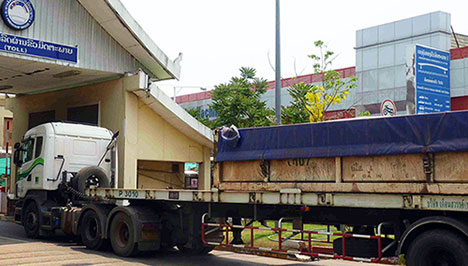Equal benefits from economic growth
When Mr Vilakone needs information about trade regulations for importing or exporting coffee he goes to one place – the Lao PDR Trade Portal.
Built with Australia's support, the Laos Government's web portal [external website] allows Mr Vilakone to search in a single site all laws, regulations and procedures for imports and exports.
'I am particularly interested in web pages that provide information related to import-export on business processes and documentation as well as general trading information,' he says.
'Information that can be obtained from this website is fast, realistic, saves time and is easy to follow.'
Hundreds of people in Mr Vilakone's company have a stake in getting coffee to market quickly and cheaply and seizing new opportunities to sell it.
The producer hires more than 350 workers to farm, buy and process beans. Mr Vilakone says Laos trade conditions have improved significantly in the past 10 years and the portal is an important step in supporting further improvement and progress towards membership of the World Trade Organization (WTO).
Facilitating trade
The portal makes trade processes more transparent and predictable for people like Mr Vilakone by providing all export and import information in a single place and offering features such as alerts on trade-related government decrees.
The portal is part of a broader Laos Government agenda – supported by Australia and other donors – to tackle domestic 'supply side' constraints, such as red tape, to expanding and diversifying trade. The aim is to expand trade in areas of the economy that are more directly linked to reducing poverty.
Australia delivers its support through the multi-donor Trade Development Facility [external website] and the Enhanced Integrated Framework [external website] – a multi-donor Aid for Trade [external website] partnership for Least Developed Countries [external website] such as Laos.
The Facility aims to facilitate trade and investment growth by supporting activities that address the institutional, policy and procedural constraints that hinder cross-border trade. Customs, trade standards compliance, quarantine, and business establishment processes are being enhanced to make it easier to trade, invest and establish businesses in Laos. The Facility is valued at US$8.25m (2007-13), with Australia contributing A$3.4m.
Laos' growth is driven by mining and hydropower, accounting for about half of total exports in 2008. This is expected to grow to almost three quarters of exports in 2020. The boom is driving Laos' economic growth rate at an average seven per cent a year – among the highest in the region – helping to halve the population below the national poverty line. However, many people have not benefited from the resources boom, with the incidence of poverty varying significantly in Laos - particularly between urban and rural areas. There are concerns the booming resources sector may hamper the competitiveness and growth of non-resources sector, including manufactured exports. To diversify and expand the trade sector, significant work is needed to improve standards, logistics, customs, infrastructure and to streamline business processes.
Removing constraints to broad and inclusive growth
Research by the World Bank in 2011 showed Laos exporters spent much more time dealing with regulatory procedures than businesses that did not trade. Laos has also ranked as one of the hardest countries to do business. Being a landlocked nation makes facilitating trade even more important. Laos is planning to build on the success of the trade portal in reducing the barriers to entry for traders by developing a 'Lao National Single Window' that will allow traders to discharge all import/export obligations through one channel electronically.
Being a landlocked nation can increase transport costs by up to 50 per cent. The Trade Development Facility is helping Laos to streamline border processes by supporting a national roll out of a new customs system that reduces time and costs at checkpoints and introduces modern border management principles.
Improving food safety and animal and plant health (sanitary and phytosanitary ) standards are important to help local producers meet export requirements and for the country's admission to the WTO. Trade Development Facility assistance in this area has included helping establish two basic laboratories in Champasack and Luang Prabang provinces.
The garment industry accounts for around 10 per cent – or $220 million – of Laos exports. A Trade Development Facility-supported Garment Skills Training Centre is training supervisors and managers on how to improve performance and productivity. The training has led to a 20 per cent increase in productivity in garment factories where staff have been trained.
Australia's assistance has helped to revise laws and regulations, including an investment promotion law that has made investing in Laos easier by treating domestic and foreign investors on an equal basis–an important requirement for Laos to become a member of the WTO.
Enhanced Integrated Framework
Laos joined the Enhanced Integrated Framework in 2004, which is a multi-donor program supporting Least Developed Counties to be more active players in the global trading system by helping them tackle supply-side constraints to trade.
The Framework sets a process for Laos to drive reforms, starting with the Laos Diagnostic Trade and Integration Study in 2006 to identify constraints to competitiveness, supply chain weaknesses and sectors of greatest growth and/or export potential. Australia was closely engaged in the processes as a donor and as the Framework Donor Facilitator from 2004 to 2010.
Laos has applied for membership of the WTO, which has been a core driver of reforms including the introduction of rules based laws and regulations and greater transparency around import and export processes.
A new Diagnostic Trade Integration Study [external website], led by the Laos Government, has mapped out the next generation of reforms.
More information
The Lao PDR Trade Portal [external website]
Laos Enhanced Integrated Framework and Trade Development Facility
Lao PDR Trade Development Facility Project [external website]
Lao PDR: New Online Platform to Boost Trade Transparency [external website]
Diagnostic Trade and Integration Study 2012 [external website]

